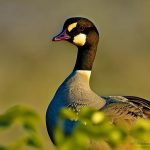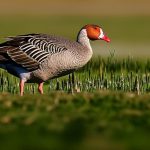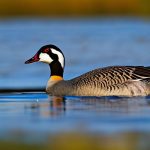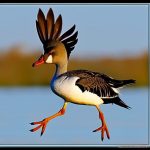Canadian Geese, also known as Canada Geese, are large waterfowl that are native to North America. They are known for their distinctive black heads and necks, white cheeks, and brown bodies. Canadian Geese are highly adaptable and can be found in a variety of habitats, including lakes, rivers, wetlands, and even urban areas.
During the breeding season, which typically occurs in the spring, Canadian Geese build nests on the ground near bodies of water. The female goose lays an average of 5-6 eggs in the nest and both parents take turns incubating the eggs for about a month until they hatch. Once the goslings hatch, they are able to walk, swim, and feed themselves within a day.
Canadian Geese play an important role in the ecosystem. They help to maintain biodiversity by dispersing seeds through their droppings and by creating habitats for other species. Additionally, they serve as indicators of environmental health, as their presence or absence can indicate the quality of a habitat.
Key Takeaways
- Canadian Geese are a common sight in North America and lay their eggs in nests on the ground.
- Protecting Canadian Geese eggs is important to maintain the population of these birds.
- Natural predators of Canadian Geese eggs include raccoons, skunks, and foxes.
- Human interference, such as disturbing nests or removing eggs, can also be a threat to Canadian Geese eggs.
- Identifying Canadian Geese nests and eggs and implementing best practices for protection can help ensure their survival.
Why it’s important to protect Canadian Geese eggs
Protecting Canadian Geese eggs is crucial for maintaining healthy populations of these birds and preserving biodiversity. Canadian Geese help to control vegetation growth by grazing on grasses and other plants, which helps to maintain open spaces for other species. They also provide food for predators such as foxes and coyotes.
Threats to Canadian Geese populations include habitat loss, pollution, hunting, and predation. By protecting their eggs, we can help ensure that these birds have a better chance of survival and can continue to fulfill their ecological roles.
Natural predators of Canadian Geese eggs
Canadian Geese eggs are vulnerable to predation by a variety of animals. Some common predators include raccoons, skunks, foxes, coyotes, gulls, crows, and snakes. These predators are attracted to the eggs because they provide a high-energy food source.
Predation can have a significant impact on Canadian Geese populations. If a nest is raided and the eggs are destroyed, the parents may not have enough time to lay another clutch before the breeding season ends. This can result in a decrease in the number of goslings that are able to hatch and survive.
Human interference as a threat to Canadian Geese eggs
Unfortunately, human interference can also pose a threat to Canadian Geese eggs. Examples of human interference include disturbance of nesting sites, destruction of nests, and harassment of nesting geese.
Disturbance of nesting sites can occur when people get too close to the nests or when they engage in activities that disrupt the geese, such as loud noises or excessive movement. This can cause the geese to abandon their nests, leaving the eggs vulnerable to predation or exposure.
Destruction of nests can occur when people intentionally remove or destroy nests in an attempt to control goose populations or to prevent damage to property. While it is understandable that some people may be concerned about the presence of geese in certain areas, it is important to find humane and effective solutions that do not harm the birds or their eggs.
Tips for identifying Canadian Geese nests and eggs
Canadian Geese nests are typically located near bodies of water, such as lakes, rivers, or ponds. They are often built on elevated areas, such as small islands or mounds, to protect them from flooding. The nests are made from a variety of materials, including grasses, twigs, and feathers.
The eggs themselves are large and have a creamy white color. They are oval-shaped and have a slightly rough texture. The number of eggs in a nest can vary, but the average clutch size is 5-6 eggs.
To identify Canadian Geese nests and eggs, look for large nests near bodies of water and search for creamy white eggs that are larger than a chicken egg. Be careful not to disturb the nest or the geese while observing.
Best practices for protecting Canadian Geese eggs

Early detection is key when it comes to protecting Canadian Geese eggs. By identifying nests early on, you can take steps to protect them before they are at risk of predation or disturbance.
To protect Canadian Geese nests, it is important to minimize disturbance and keep a safe distance from the nest. Avoid loud noises, excessive movement, or any other activities that may cause the geese to abandon their nest. If you come across a nest, mark its location and avoid going near it unless absolutely necessary.
Tools and techniques for keeping predators away from Canadian Geese nests
There are several effective tools and techniques that can be used to keep predators away from Canadian Geese nests. One common method is the use of predator deterrents, such as motion-activated sprinklers or lights. These devices startle predators and discourage them from approaching the nest.
Another technique is the use of physical barriers, such as fences or netting, to prevent predators from accessing the nest. These barriers should be installed in a way that allows the geese to enter and exit the nest freely, but prevents predators from getting in.
The role of community engagement in protecting Canadian Geese eggs
Community engagement is crucial when it comes to protecting Canadian Geese eggs. By involving the community in conservation efforts, we can raise awareness about the importance of these birds and their eggs and encourage people to take action to protect them.
One way to engage the community is through educational programs and workshops. These can be held at schools, community centers, or other public spaces and can include presentations, hands-on activities, and guided nature walks.
Another way to engage the community is through volunteer opportunities. This can include participating in nest monitoring programs, assisting with habitat restoration projects, or helping to install and maintain predator deterrents.
Legal implications of harming Canadian Geese or their eggs
It is important to note that harming Canadian Geese or their eggs is illegal in many jurisdictions. These birds are protected under various laws and regulations, including the Migratory Bird Treaty Act in the United States and the Migratory Birds Convention Act in Canada.
Violating these laws can result in fines, imprisonment, or both. It is important to familiarize yourself with the laws in your area and to report any illegal activities involving Canadian Geese or their eggs to the appropriate authorities.
Our responsibility to protect Canadian Geese and their eggs
In conclusion, protecting Canadian Geese and their eggs is crucial for maintaining healthy populations of these birds and preserving biodiversity. They play an important role in the ecosystem by controlling vegetation growth and providing food for predators.
By identifying nests early on and taking steps to protect them from predators and human interference, we can help ensure the survival of Canadian Geese and their eggs. Community engagement is also key, as it raises awareness about the importance of these birds and encourages people to take action to protect them.
It is our responsibility to protect Canadian Geese and their eggs. By doing so, we are not only preserving a species, but also contributing to the overall health and balance of our ecosystems. So let’s take action and make a difference for these beautiful birds.
If you’re looking for ways to protect Canadian geese eggs from being eaten, you might find this article on poultrywizard.com helpful. It provides valuable information on how to design a chicken coop in Chester, SC, that can keep predators away from your geese eggs. Additionally, the article discusses the incubation period for goose eggs and offers insights into the ideal chicken coop door size to prevent unwanted intrusions. Check out the article here for practical tips on safeguarding Canadian geese eggs.
FAQs
What are Canadian geese?
Canadian geese are a species of waterfowl that are native to North America. They are known for their distinctive black heads and necks, white cheeks, and brown bodies.
Why is it important to keep Canadian geese eggs from being eaten?
Canadian geese are a protected species in many areas, and their eggs are an important part of their reproductive cycle. If too many eggs are eaten by predators, it can have a negative impact on the population of Canadian geese.
What are some predators that eat Canadian geese eggs?
Predators that commonly eat Canadian geese eggs include raccoons, skunks, foxes, and crows.
How can I protect Canadian geese eggs from predators?
There are several methods for protecting Canadian geese eggs from predators, including using decoys, installing fencing or netting around nesting areas, and using scare tactics such as loud noises or flashing lights.
Is it legal to interfere with Canadian geese eggs?
In many areas, it is illegal to interfere with Canadian geese eggs or nests without a permit. It is important to check with local wildlife authorities before attempting to protect Canadian geese eggs.
Meet Walter, the feathered-friend fanatic of Florida! Nestled in the sunshine state, Walter struts through life with his feathered companions, clucking his way to happiness. With a coop that’s fancier than a five-star hotel, he’s the Don Juan of the chicken world. When he’s not teaching his hens to do the cha-cha, you’ll find him in a heated debate with his prized rooster, Sir Clucks-a-Lot. Walter’s poultry passion is no yolk; he’s the sunny-side-up guy you never knew you needed in your flock of friends!







